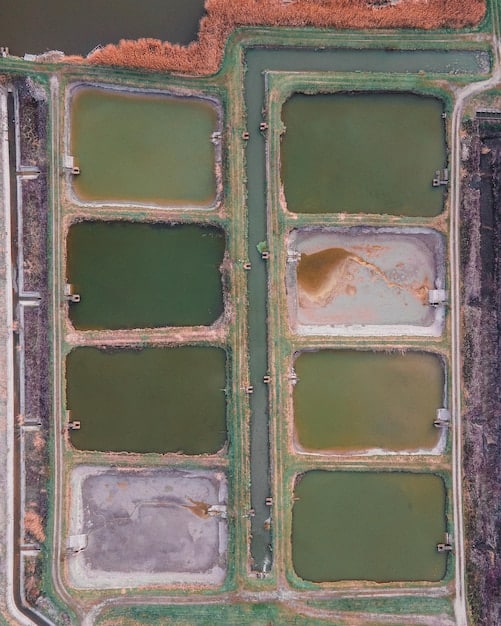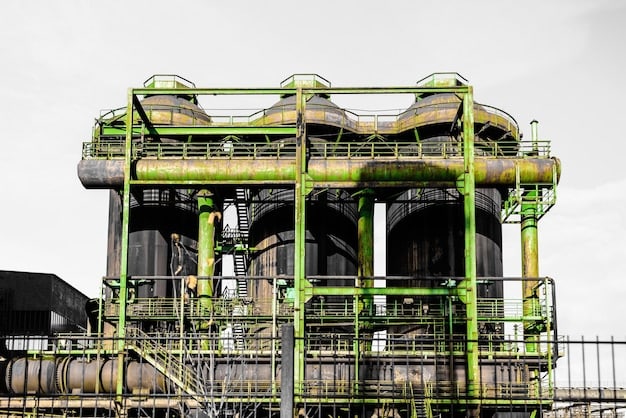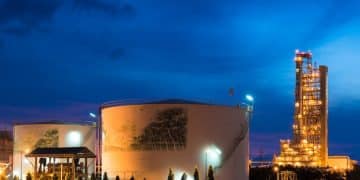Algae Biofuel: Can It Power US Transportation by 2026?

Algae biofuel breakthroughs show promise, but whether they’re ready to power US transportation by 2026 depends on overcoming scalability, cost, and infrastructure challenges despite ongoing research and development efforts.
The quest for sustainable transportation fuels is becoming increasingly urgent. Are algae biofuel breakthroughs ready to power US transportation by 2026? This question sparks considerable debate as researchers and companies race to unlock algae’s potential.
The Promise of Algae Biofuel
Algae biofuel is derived from algae, a diverse group of photosynthetic organisms that can convert sunlight, water, and carbon dioxide into lipids, proteins, and carbohydrates. These lipids can then be processed into biodiesel or other biofuels.
One of the most compelling aspects of algae biofuel is its potential to reduce reliance on fossil fuels and mitigate greenhouse gas emissions. Unlike traditional biofuels derived from crops like corn or soybeans, algae can be grown on non-arable land, avoiding competition with food production. Algae also have a much higher lipid yield per acre compared to these crops. This higher yield means more biofuel can be produced from a smaller land area.
Benefits of Algae Biofuel Over Traditional Biofuels
- Higher Lipid Yield: Algae produce significantly more oil per acre compared to traditional biofuel crops.
- Non-Arable Land Use: Algae can be grown on land unsuitable for agriculture, minimizing competition with food production.
- Carbon Sequestration: Algae consume carbon dioxide during growth, helping to reduce greenhouse gas emissions.
- Water Usage: Some algae strains can be grown in saltwater or wastewater, reducing the demand on freshwater resources.
Beyond these environmental benefits, algae biofuel also offers potential economic advantages. The development of a thriving algae biofuel industry could create new jobs and stimulate economic growth in rural communities. Algae cultivation can also be integrated with wastewater treatment facilities, providing a cost-effective way to simultaneously produce biofuel and clean wastewater.
In conclusion, algae biofuel presents a promising alternative to conventional fuels, with the potential to address environmental and economic challenges. The crucial question, however, remains: Can these promises translate into widespread use by 2026?
Current State of Algae Biofuel Technology
The current state of algae biofuel technology is characterized by significant advancements in recent years, but also persistent challenges that need to be overcome before widespread commercialization can occur.
Researchers and companies have made substantial progress in improving algae cultivation techniques, lipid extraction methods, and biofuel conversion processes. Advances in genetic engineering have led to the development of algae strains with higher lipid content and faster growth rates. Innovative bioreactor designs are also being explored to enhance algae productivity and reduce energy consumption.

However, several key challenges still remain. One of the most significant hurdles is the high cost of algae biofuel production. The cost of cultivating algae, extracting lipids, and converting them into biofuel is currently higher than the cost of producing traditional fuels. High energy inputs, nutrient costs, and infrastructure requirements contribute to the overall expense.
Challenges in Algae Biofuel Production
- High Production Costs: The cost of algae cultivation, lipid extraction, and conversion remains high.
- Scalability: Scaling up algae production to meet transportation fuel demands is a significant challenge.
- Nutrient Requirements: Algae require nutrients like nitrogen and phosphorus, which can be costly and environmentally problematic.
- Harvesting and Extraction: Efficient and cost-effective methods for harvesting algae and extracting lipids are needed.
Another challenge is scalability. While algae can be grown in relatively small-scale facilities, scaling up production to meet the massive demand for transportation fuels is a major undertaking. This requires significant investments in infrastructure, including large-scale cultivation ponds or bioreactors, processing plants, and transportation networks.
In summary, while algae biofuel technology has made considerable strides, significant challenges related to cost, scalability, and infrastructure need to be addressed to facilitate its widespread adoption. Ongoing research and development efforts are crucial to overcoming these hurdles and realizing the full potential of algae biofuel.
Economic Feasibility and Cost Reduction Strategies
The economic feasibility of algae biofuel is a critical factor determining its potential to power US transportation by 2026. Currently, the cost of producing algae biofuel is higher than that of conventional fossil fuels, making it difficult for algae biofuel to compete in the market.
A variety of strategies are being explored to reduce the production costs of algae biofuel. One approach focuses on optimizing algae cultivation to increase lipid yields and reduce nutrient requirements. This includes developing more efficient bioreactor designs, improving algae strain selection, and optimizing cultivation conditions such as temperature, light, and nutrient supply.
Another strategy involves integrating algae biofuel production with other industries to reduce costs and generate additional revenue streams. For example, algae can be grown using wastewater from municipal or industrial sources, reducing the cost of water and nutrients. Algae biomass remaining after lipid extraction can be used as animal feed or as a feedstock for biogas production.
Cost Reduction Strategies for Algae Biofuel
- Optimizing Cultivation: Improving lipid yields and reducing nutrient requirements through strain selection and optimized cultivation conditions.
- Integrated Production: Combining algae biofuel production with wastewater treatment or other industrial processes to reduce costs and generate additional revenue.
- Byproduct Utilization: Using algae biomass remaining after lipid extraction as animal feed or feedstock for biogas production.
Technological advancements in lipid extraction and conversion processes are also expected to play a significant role in reducing costs. Researchers are exploring more efficient and cost-effective methods for extracting lipids from algae biomass and converting them into biodiesel, renewable diesel, and other biofuels.
Government policies and incentives can also help to improve the economic feasibility of algae biofuel. Tax credits, subsidies, and mandates for renewable fuels can create a more favorable market environment for algae biofuel and encourage investment in algae biofuel production facilities. As the industry matures and economies of scale are achieved, the cost of algae biofuel is expected to decrease, making it more competitive with conventional fuels.
In conclusion, reducing the cost of algae biofuel production is essential for its widespread adoption. A combination of technological advancements, integrated production strategies, byproduct utilization, and supportive government policies will be needed to make algae biofuel economically viable and competitive in the transportation fuel market.
Infrastructure and Distribution Challenges
Even with technological breakthroughs and cost reductions, the widespread adoption of algae biofuel faces significant infrastructure and distribution challenges. The existing infrastructure for transporting, storing, and dispensing petroleum-based fuels is not readily compatible with algae biofuel.
Algae biofuel production facilities need to be located near sources of water, carbon dioxide, and nutrients, which may not be in close proximity to existing transportation infrastructure. This can create logistical challenges and increase transportation costs. Furthermore, algae biofuel may have different properties than conventional fuels, requiring modifications to existing pipelines, storage tanks, and dispensing equipment.

Another challenge is the lack of a dedicated distribution network for algae biofuel. Unlike gasoline and diesel, which are readily available at gas stations across the country, algae biofuel is not yet widely available to consumers. Establishing a distribution network for algae biofuel will require significant investments in new infrastructure and coordination among producers, distributors, and retailers.
Infrastructure and Distribution Needs
- Transportation: Developing efficient transportation networks to move algae biomass and biofuel from production facilities to processing plants and distribution centers.
- Storage: Constructing storage facilities to accommodate the unique properties of algae biofuel.
- Distribution: Establishing a dedicated distribution network to make algae biofuel readily available to consumers.
Overcoming these infrastructure and distribution challenges will require collaboration between government, industry, and research institutions. Government support for infrastructure development, coupled with industry investments in new technologies and distribution networks, can help to pave the way for the widespread adoption of algae biofuel.
Moreover, public awareness and acceptance are crucial for creating demand for algae biofuel. Educating consumers about the benefits of algae biofuel and promoting its use can help to drive market demand and encourage investment in algae biofuel production and distribution infrastructure. Addressing these infrastructure and distribution challenges is essential for realizing the potential of algae biofuel to power US transportation.
Environmental Impact and Sustainability
Algae biofuel holds the promise of being a more environmentally sustainable alternative to traditional fossil fuels. However, it’s crucial to evaluate its full environmental impact to ensure its sustainability.
One of the key benefits of algae biofuel is its potential to reduce greenhouse gas emissions. Algae consume carbon dioxide during photosynthesis, which can help to offset emissions from transportation. Studies have shown that algae biofuel can significantly reduce lifecycle greenhouse gas emissions compared to petroleum-based fuels.
Algae cultivation can also minimize land use impacts. Unlike traditional biofuels that require arable land, algae can be grown on non-arable land, preventing competition with food crops. Some algae strains can even be grown in saltwater or wastewater, reducing the demand on freshwater resources.
While algae biofuel offers several environmental advantages, it is important to consider potential drawbacks. Algae cultivation requires nutrients like nitrogen and phosphorus, which can contribute to water pollution if not managed properly. The energy required for algae cultivation, lipid extraction, and biofuel conversion can also have environmental impacts.
Environmental Considerations for Algae Biofuel
- Greenhouse Gas Emissions: Algae biofuel can significantly reduce lifecycle greenhouse gas emissions.
- Land Use: Algae can be grown on non-arable land, minimizing competition with food production.
- Water Use: Certain algae strains can be grown in saltwater or wastewater.
To ensure the sustainability of algae biofuel, best management practices must be implemented to minimize environmental impacts. This includes optimizing nutrient management to prevent water pollution, using renewable energy sources to power algae cultivation and processing facilities, and implementing efficient water management strategies to reduce water consumption.
Life cycle assessments are also essential for evaluating the full environmental impact of algae biofuel, from cultivation to combustion. These assessments can help identify potential environmental hotspots and inform strategies for improving the sustainability of algae biofuel production.
In conclusion, algae biofuel has the potential to be a more environmentally sustainable alternative to traditional fossil fuels, but careful attention must be paid to minimizing potential environmental impacts through best management practices and life cycle assessments.
Future Outlook and Projections for 2026
Looking ahead to 2026, the question remains: Can algae biofuel breakthroughs truly power US transportation on a significant scale? Current projections suggest a mixed outlook, with both opportunities and challenges on the horizon.
Significant investments are being made in algae biofuel research and development. Government agencies, private companies, and research institutions are funding projects aimed at improving algae cultivation techniques, reducing production costs, and addressing infrastructure challenges.
The US Department of Energy has set ambitious goals for the production of renewable fuels, including algae biofuel. These goals are driving innovation and investment in the algae biofuel industry. Government policies, such as the Renewable Fuel Standard, also provide incentives for the production and use of biofuels.
However, significant hurdles remain. The pace of technological advancements may not be fast enough to achieve widespread commercialization by 2026. The high cost of production, coupled with infrastructure and distribution challenges, could limit the adoption of algae biofuel.
Factors Influencing the Future of Algae Biofuel
- Technological Advancements: Continued progress in algae cultivation, lipid extraction, and biofuel conversion is essential.
- Cost Reduction: Reducing the cost of algae biofuel production is crucial for its competitiveness.
- Policy Support: Government policies and incentives can help to drive the adoption of algae biofuel.
Despite these challenges, there are reasons to be optimistic. Breakthroughs in genetic engineering, bioreactor design, and integrated production strategies could accelerate the development of algae biofuel technologies. A growing demand for sustainable transportation fuels and increasing concerns about climate change could also boost the prospects for algae biofuel.
While it is unlikely that algae biofuel will completely replace conventional fuels by 2026, it could play a more significant role in the US transportation sector. Algae biofuel may be used in niche applications, such as aviation or heavy-duty trucking, where its unique properties make it particularly attractive.
In summary, the future of algae biofuel is dependent on continued technological advancements, cost reductions, supportive government policies, and growing demand for sustainable transportation fuels. While challenges remain, the potential of algae biofuel to power US transportation is significant, and ongoing research and development efforts are paving the way for a more sustainable energy future.
| Key Point | Brief Description |
|---|---|
| 🌱 High Lipid Yield | Algae produce more oil per acre than traditional crops. |
| 🌎 Non-Arable Land | Algae can be grown on land unsuitable for food crops. |
| 💰 Cost Challenges | High production costs hinder widespread adoption. |
| ⛽ Infrastructure Needs | New infrastructure is needed for distribution. |
FAQ
▼
Algae biofuel is a fuel derived from algae, a type of fast-growing, photosynthetic microorganism. It can be converted into biofuels like biodiesel, offering a renewable alternative to fossil fuels.
▼
Algae biofuel has several advantages, including high lipid yield, the ability to grow on non-arable land, carbon sequestration during growth, and the potential to use waste water.
▼
The main challenges include high production costs related to cultivation, harvesting, and processing, as well as the need for significant infrastructure and efficient nutrient management.
▼
Costs can be reduced through optimizing cultivation, integrating production with wastewater treatment, utilizing byproducts as animal feed or biogas feedstock, and technological advancements in lipid extraction.
▼
The future depends on technological advancements, cost reductions, supportive government policies, and growing demand for sustainable transportation fuels, with potential niche applications in aviation and heavy-duty trucking.
Conclusion
In conclusion, while algae biofuel holds significant promise as a sustainable alternative to fossil fuels, its widespread adoption in US transportation by 2026 faces considerable challenges. Overcoming these hurdles requires continued innovation, strategic investments, and supportive policies to unlock its full potential and contribute to a greener energy future.





